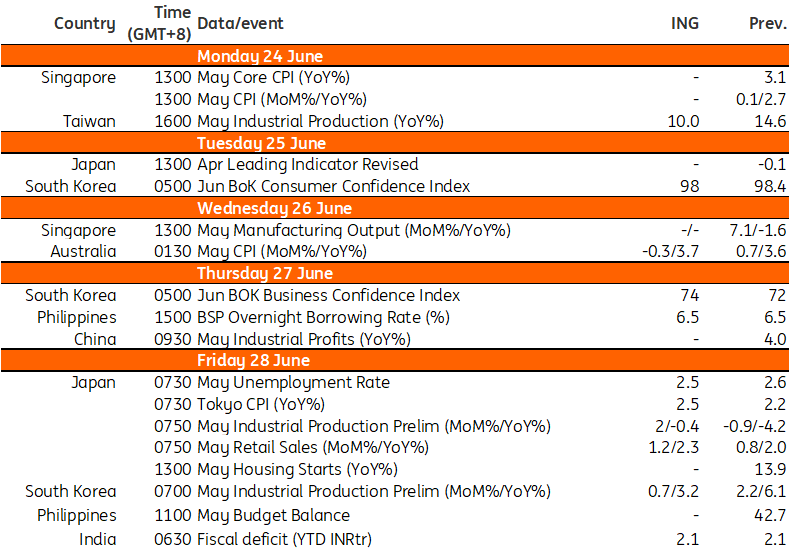We could see pressure building for additional monetary tightening in some APAC economies in the coming week. Meanwhile, North Asia (ex-China) delivers the monthly activity data dump which should show external demand still providing support
Inflation and Central Banks
Following the revelation that the Reserve Bank of Australia (RBA) discussed rate hikes at its last meeting (and that is not a typo – we did mean hikes, not cuts), the May CPI data will probably raise the question, “well, why didn’t they?”
We think that the May data will show a 0.3% month-on-month decline in the price level, mainly driven by seasonal declines in holiday prices as well as clothing. On top of this, we will also see some influence from sharply lower retail gasoline prices. But the May 2023 CPI index also suffered from the same negative influences, and we think the 2023 drag from recreation was larger than we will see this year.
The net result of all of this will be an inflation rate that could edge higher again from 3.6% year-on-year to 3.7%, with an outside chance that it rises to 3.8%. Australian inflation hasn’t fallen on a monthly basis since it troughed in December 2023 at 3.4%. Pressure to respond with higher rates has to be growing. If we see inflation rise again, we will think very hard about incorporating a rate hike in our forecasts. There is still one more inflation reading (31 July) before the 6 August RBA meeting, and that is the more important quarterly report for the second quarter of this year, so it’ll be a high-risk gamble if we do.
Japan also publishes Tokyo CPI data for June. This could be the highlight of the week for Japan as the Tokyo number provides a gauge of the nationwide CPI trend ahead. We expect Tokyo’s inflation to accelerate to 2.5% YoY in June from 2.2% in May due to a pickup in pipeline prices. If inflationary pressures become more dominant over the next two months, then the possibility of a July rate hike will increase significantly.
Another central bank that may be under some pressure to review its rate stance next week is the Bangko Sentral ng Pilipinas (BSP). There is little chance of a hike here, but Governor Eli Remolona’s recent suggestion that the BSP would not need to wait for the Federal Reserve before cutting rates has been silenced by PHP weakness (probably as a direct result). The PHP is the region’s weakest currency month-to-date and has needed BSP intervention to support it. More recent comments from other BSP officials have re-grouped behind the view that the BSP will be on hold until after the Fed.
We are not looking for any change in BSP policy at this meeting, absent any sudden weakening in the PHP, which could follow any suggestion that front-running the Fed was being reconsidered. Let’s hope not.
North Asia (ex-China) Is Being Supported by Semiconductors and Tourism
As well as inflation data, Japan also publishes its monthly industrial production and labour reports on Friday 28 June. The normalisation of auto production should have a positive impact on the economy and will boost employment and manufacturing production. In addition, retail sales should grow thanks to strong tourism and a steady improvement in labour market conditions.
South Korean industrial production should also rise in May. Semiconductor output is expected to rebound after two months of decline as inventories are restocked. However, exports and industry data point to a decline in auto production, so the overall monthly gain is likely to be modest. Retail sales will most likely fall due to a drop in car sales. But this should be partially offset by an increase in consumer goods sales, which will be boosted by an increase in foreign tourists during the May holidays.
Apart from the monthly activity data, survey data is also due for release. Strong external demand for chips and autos should boost business sentiment, especially in the manufacturing sector. The consumer confidence index is likely to remain below 100 as tight credit conditions and sluggish asset market performance are still weighing on consumer sentiment.
Indian Fiscal Data for May
May fiscal deficit figures for May are released on 28 June. So far this year, the deficits have been coming in close to last year’s INR totals, which is likely to be sufficient to keep the deficit on target for the government’s 5.4% (GDP) fiscal year deficit for 2024/25. Something in the vicinity of last year’s INR 2.1tr deficit for May 2023 will keep things on track.
Strong fiscal discipline is one of the reasons for the improvement in the outlook for India’s sovereign credit rating to positive by S&P recently, so we mustn’t see any slippage here following the recent election.
A Quiet Week for Greater China After the Recent Data Dump
It is a very quiet week ahead for Greater China. Mainland China will publish its May industrial profits data on Thursday. Profit growth has been flat at 4.3% YoY in the last two months and something similar in May looks probable.
Taiwan will publish its May industrial production and employment data on Monday. We expect a moderation of industrial production to around 10% YoY from last month’s 14.6% YoY, though this mostly reflects the timing of the upturn in production volumes last year. The underlying trend is still positive, albeit slowing.
Finally, Hong Kong publishes its trade data on Tuesday and money supply data on Wednesday. No excitement is expected from any of these data points.
Key Events in Asia Next Week

Source: Refinitiv, ING

